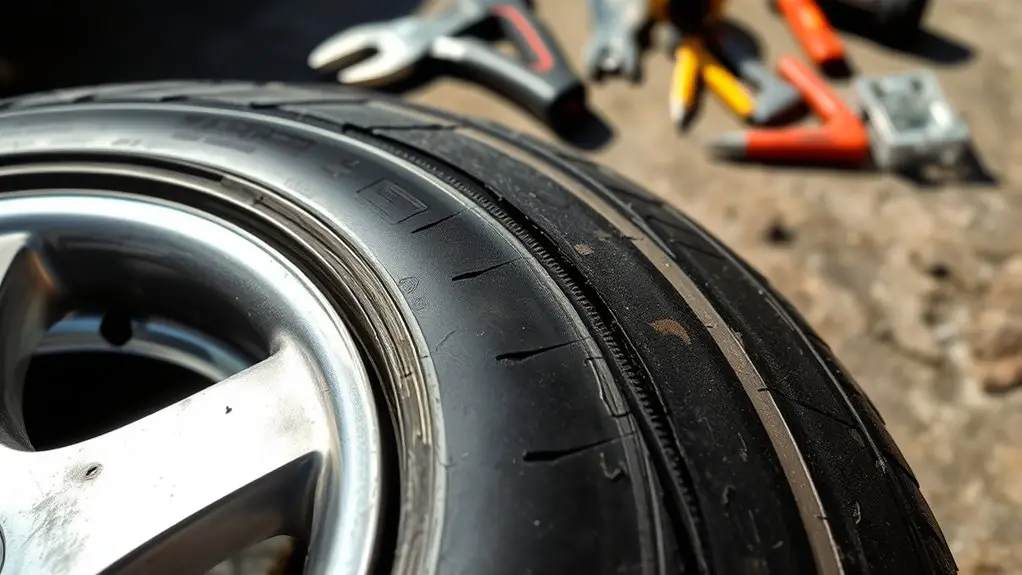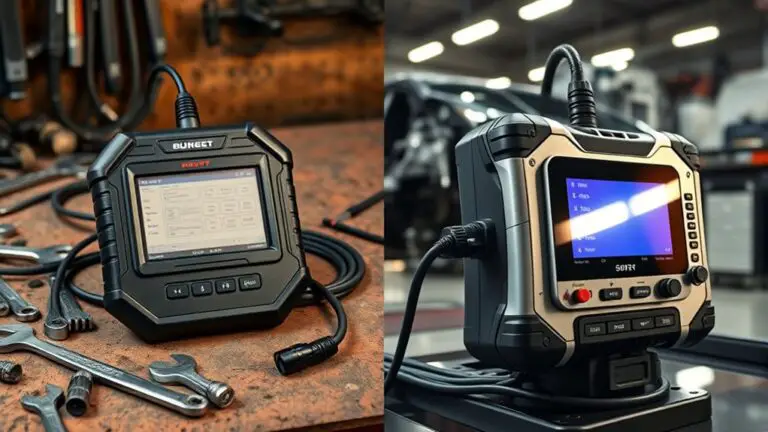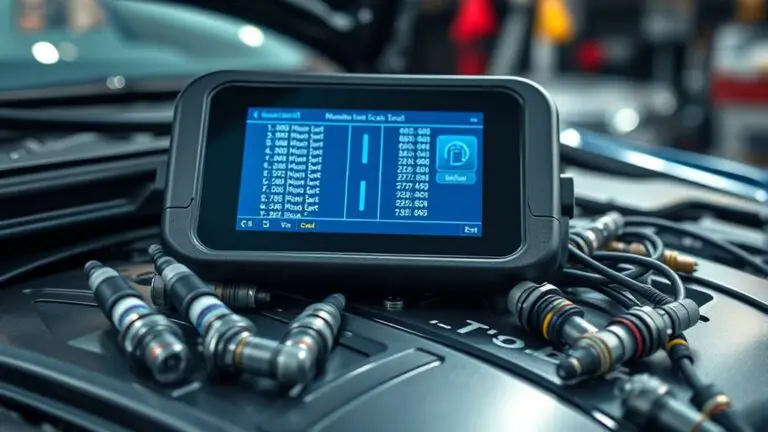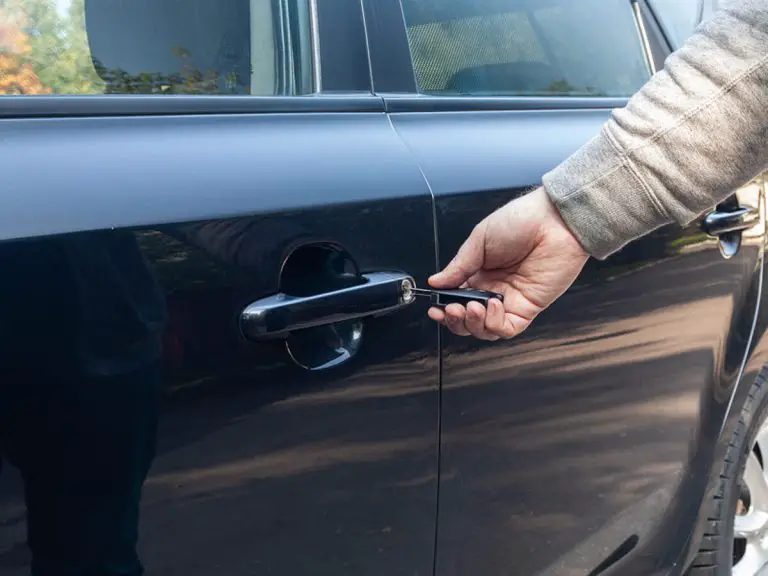TPMS Troubleshooting: Causes of Dry Rot and Fixes
Dry rot in TPMS components can degrade the sensor housing, valve stem seals, and gaskets, causing intermittent readings and false alerts. Inspect for brittleness, chalking, or cracks, and test for pressure decay to reveal degraded seals. Moisture ingress corrodes connectors and enclosures, so check grommets and vent paths for leaks. Electrical aging raises resistance in pins and solder joints, while battery leakage shortens life. Proper calibration, steady power, and thorough maintenance reduce risk; continuing attention reveals more fixes.
Diagnosing Dry Rot Impact on TPMS Sensors
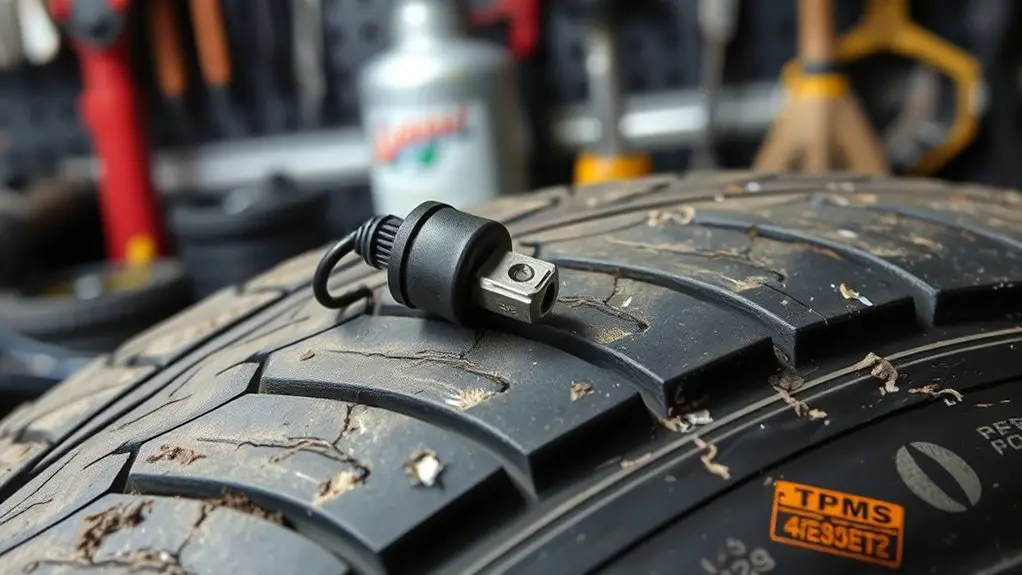
Dry rot can compromise TPMS sensors by degrading the sensor housing, valve stem, and seals, which may lead to intermittent readings or sensor failure. You’ll evaluate how dry rot alters signal reliability by inspecting housing integrity, seal tension, and stem susceptibility to cracking. Begin with a tactile assessment: look for brittleness, chalking, or crust on rubber components, then confirm with a simple pressure test to observe pressure decay rates. Next, correlate observed degradation with sensor performance data—unusual low battery indicators, delayed activation, or sporadic tire pressure reports signal potential contact with dry-rot effects. Document findings with exact tire condition and wear patterns, noting if corrosion or abrasion is present where the stem exits the rim. Consider environmental exposure, UV impact, and chemical contact as contributing factors to accelerated aging. You’ll prioritize interventions that preserve sensor lifespan by replacing compromised components and ensuring proper seating, seals, and protective lubrication where appropriate.
Aging TPMS Components: What Fails Over Time

Aging TPMS components exhibit predictable failure patterns as materials wear and electronics drift, affecting reliability and accuracy. You’ll notice sensors losing signal integrity as seals, housings, and gaskets degrade under vibration, temperature swings, and road exposure. Sensor lifespan shortfalls often arise from battery chemistry, electrolyte leakage, and radio-frequency calibration drift, not just mechanical wear. In the wheel-end electronics, connector pins corrode, solder joints fracture, and cable insulation hardens, increasing contact resistance and intermittent fail states. Structural components suffer from metal fatigue and plastic creep, reducing mounting rigidity and calibration stability. Internal filters clog or shift, compromising pressure sensing and temperature compensation. Firmware updates may address known drift behaviors, but aging hardware sets hard limits on performance. You should expect gradual accuracy decline, with warning codes or degraded duty cycles signaling pending failure. Planning preventative maintenance around known deterioration timelines improves reliability and allows timely replacement before critical loss of functionality.
Moisture Ingress and Sensor Corrosion
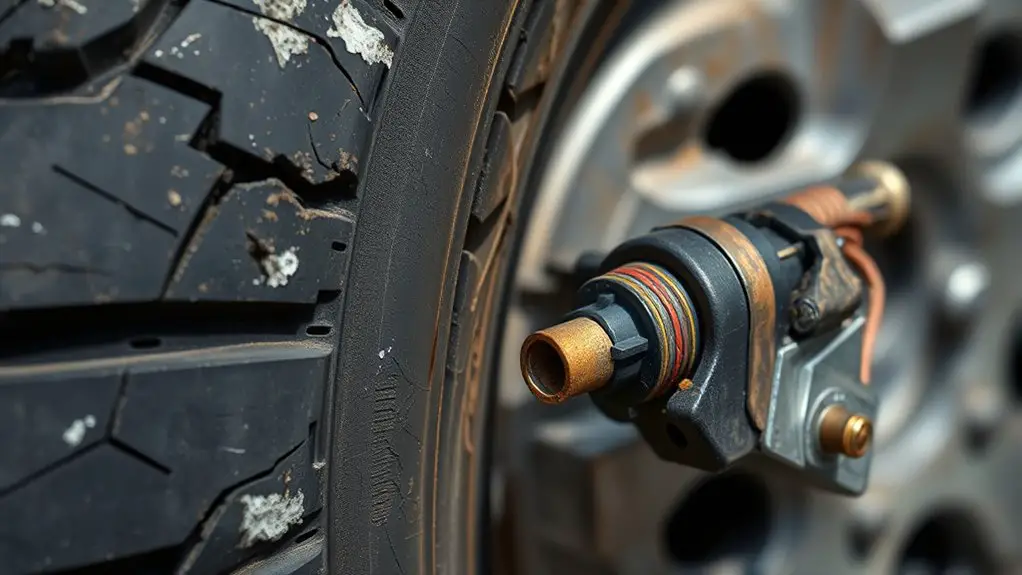
Moisture ingress and sensor corrosion directly impact TPMS reliability once aging components have started to degrade. You’ll see compromised sensor signals when exposed seals, permeable housings, or failed polyurethane potting allow humidity to reach electronics. Moisture management becomes critical: even brief exposure can create ionic pathways, corrosion, or dendritic deposits on contact pads, leading to drift, false alerts, or missed warnings. You should inspect the enclosure integrity, vent paths, and grommet seals for cracks or deformation, replacing damaged parts promptly. Condensation inside sensor modules indicates inadequate sealing or temperature cycling issues; address these by verifying IP ratings, applying proper sealing compounds, and ensuring desiccants are positioned correctly. Sensor protection relies on proper cable strain relief, resistant coatings, and obstruction-free air pathways to prevent moisture buildup. Maintain a proactive maintenance cadence, document ingress events, and deploy corrective actions to minimize corrosion risk and preserve TPMS accuracy over the vehicle’s service life.
Electrical Issues: Voltage Fluctuations and Grounding
Voltage stability factors you’ll examine include supply regulation, transient response, and load-induced voltage drops. Grounding best practices focus on a low-impedance path, proper bonding, and mitigating stray currents to protect sensor electronics. Together, these points establish a foundation for reliable TPMS operation and accurate pressure readings.
Voltage Stability Factors
Voltage stability factors refer to how electrical supply conditions—voltage levels, transients, and grounding integrity—affect TPMS sensor performance and communication reliability. You’ll assess how voltage regulation guarantees consistent sensor power, minimizing drift in sensor readings and preventing false alerts. Transients, such as load surges or switching events, can momentarily derail radio links and data integrity, so you’ll prioritize suppression and filtering strategies. Grounding integrity underpins signal reference stability; poor grounding introduces noise and offset that degrade message clarity. You’ll focus on maintaining stable voltage rails, filtering noise on supply lines, and verifying clean ground paths to preserve sensor stability. This approach preserves reliable tire-pressure reporting, supports timely fault detection, and keeps the system resilient amid vehicle electrical demands.
Grounding Best Practices
Grounding is the foundation for TPMS reliability, so establish and verify low-impedance return paths and a solid chassis reference to minimize noise coupling and signal offset. You’ll implement structured grounding techniques that minimize loop area and reduce differential noise between sensors and the ECU. Use star or single-point grounding to avoid daisy-chaining, and terminate shielding only at the source when appropriate to preserve signal integrity. Confirm capable grounding conductors meet current and surge requirements, and verify continuity with acceptable resistance values under load. Apply sensor shielding where EMI is plausible, grounding shields to the chassis or common ground plane to maintain signal fidelity. Document procedures, test points, and acceptance criteria to sustain repeatable results across vehicles and service cycles.
Calibration Errors That Skew Readouts
Calibration errors can skew TPMS readouts when sensors, transducers, or controllers misinterpret stored calibration data or drift over time. You’ll notice subtle shifts in tire status, with readouts that don’t reflect actual pressures. The root cause often lies in sensor calibration; a small offset, temperature compensation misalignment, or clock drift can propagate into readout discrepancies across the system. You should verify that each sensor’s calibration constants match the factory specification and that software updates haven’t altered reference values. When diagnosing, distinguish between sensor drift and improper initial calibration, since both produce divergent results. Use a calibrated reference gauge to cross-check readings at multiple tires under controlled conditions, logging discrepancies for trend analysis. Confirm calibration routines are executed with stable environmental factors and validated by a known-good transducer. Maintain a disciplined change-management process to prevent inadvertent offsets, and document every adjustment for future troubleshooting. This approach preserves measurement integrity and supports reliable, freedom-loving diagnostics.
Battery and Power Supply Problems
You’ll want to first verify battery sourcing reliability, ensuring compatibility with TPMS hardware and environmental specs. Next, assess power supply compatibility, checking voltage, current, connector standards, and ripple characteristics to prevent sensor glitches. Finally, consider backup power options and failure modes to maintain system operation during supply interruptions.
Battery Sourcing Issues
Battery sourcing issues arise when the TPMS requires a reliable power supply that isn’t readily available from the vehicle’s primary battery or secondary sources. You’ll assess supply robustness, identify gaps, and choose intentional sourcing paths that preserve performance and autonomy. Below, a concise framework helps you act with precision:
- Verify battery compatibility with sensor electronics and voltage thresholds.
- Catalog sourcing alternatives, including auxiliary packs, bootstrapped power rails, or dedicated TPMS modules.
- Evaluate regulatory and thermal constraints to prevent spillover effects on other systems.
- Implement a monitoring plan that flags voltage sag before sensor misbehavior occurs.
Following these steps keeps the system responsive, avoids dry-rot symptoms, and supports dependable tire health.
Power Supply Compatibility
Power supply compatibility hinges on guaranteeing the TPMS electronics receive stable, appropriately leveled power. You’ll verify that input voltages stay within specified ranges, avoiding spikes that could cause misreads or firmware faults. Identify power supply types compatible with your unit, distinguishing between regulated and unregulated sources, and confirm ripple and noise levels meet tolerance specs. Perform a controlled connection test to observe startup behavior, steady-state operation, and response to transient loads. Document any voltage drop under load and guarantee grounding is solid to prevent interference. For reliability, implement compatibility testing across common automotive environments, including temperature and vibration scenarios. Maintain a concise log of results, noting required adapters or adapters’ polarity, to prevent inadvertent damage.
Backup Power Options
Backup power options are essential when TPMS systems must remain reliable during vehicle supply interruptions; this section covers both battery and external power supply considerations, including capacity requirements, charging behavior, and fault handling. You’ll evaluate how backup solutions sustain operation, manage energy density, and guarantee power redundancy under load spikes and temperature shifts.
1) Assess battery capacity vs. expected run time, factoring worst-case tire pressure updates and alert generation.
2) Define charging behavior, including acceptable charging rates, state of charge targets, and avoidance of deep discharge.
3) Specify fault handling protocols for undervoltage, overvoltage, or connector loss, with clear recovery steps.
4) Verify power redundancy with failover tests, remediation paths, and documentation for maintenance intervals.
Signal Interference and Antenna Problems
Signal interference can degrade TPMS signal quality and trigger erroneous readings, so identify and mitigate competing RF sources, shielding gaps, and antenna alignment issues. You’ll verify that nearby devices, wireless accessories, and lab equipment aren’t emitting conflicting signals that saturate the 315/433 MHz or 2.4 GHz bands used by TPMS. Inspect shielding continuity and ground paths, sealing gaps in pinch points, harness housings, and antenna mounts to prevent bleed-through. Evaluate antenna alignment: guarantee the sensor and receiver antennas are oriented per manufacturer guidelines, free from deformation, and not obstructed by metallic surfaces or structural components. Consider mechanical movement, vibration, or mounting fatigue that can shift polarity or radiation patterns over time. If readings remain unstable, map RF emissions with a spectrum analyzer to locate transient sources, then implement channel changes or physical re-routing. Document changes and test under real driving conditions to confirm sustained reliability, avoiding false alerts while preserving vehicle freedom.
Proper Maintenance Practices to Prevent Dry Rot
Dry rot prevention starts with a proactive maintenance routine that targets moisture control, material condition, and drainage. You’ll implement a disciplined approach that emphasizes repeatable checks, documented results, and minimal downtime, while preserving tire health and TPMS reliability. To keep the system robust, follow these preventive measures with a focus on predictable outcomes and safe operation.
Dry rot prevention hinges on steady, documented maintenance for moisture control and reliable TPMS performance.
1) Inspect seals and housings monthly for cracks or wicking, replacing compromised components promptly.
2) Monitor interior climate and drainage around wheels to minimize condensation and standing water exposure.
3) Schedule regular tire care inspections, ensuring correct mounting, balancing, and air pressures to reduce uneven stress.
4) Maintain a proactive log of wear, corrosion indicators, and fastener torque, triggering early interventions before failures occur.
These steps support durable materials, effective drainage, and consistent performance. You’ll reduce dry rot risk while sustaining tire care and TPMS integrity.
When to Call a Pro: Professional TPMS Diagnostics
If you notice persistent TPMS warnings despite correct tire mounting and pressures, or if service indicators blink intermittently and then stabilize without a clear cause, it’s time to bring in a professional. Professional TPMS diagnostics provide definitive fault isolation, avoiding guesswork that can mask underlying sensor, module, or calibration problems. You’ll benefit from targeted TPMS services that verify sensor integrity, reprogramming, and system synchronization with the vehicle’s ECU. A skilled technician conducts live data analysis, harness testing, and fault-code mapping to determine whether a sensor replacement, module update, or recalibration is required. Expect documented results, recommended corrective actions, and a precise timeline for repairs. For fleet or performance vehicles, professional inspections guarantee compliance and reliability, reducing downtime. In short, trusted experts diagnose, repair, and verify system readiness so you retain control and confidence behind the wheel.
| Step | Action | Outcome |
|---|---|---|
| 1 | Inspect sensors | Confirm integrity |
| 2 | Read codes | Localize fault |
| 3 | Verify calibration | Ascertain accuracy |
Frequently Asked Questions
How Long Does TPMS Dry Rot Typically Take to Develop?
Dry rot from TPMS-related issues isn’t a fixed timeline; it develops over months to years depending on exposure and maintenance. You’ll see accelerated deterioration if tires sit undeployed, moisture ingress, or improper pressure persist. TPMS lifespan factors include cyclic loading, heat, and sunlight exposure. Regular tire maintenance tips—keep tires inflated to spec, rotate regularly, inspect for cracks, and store properly—can slow progression. Stay vigilant; prompt attention minimizes risk and preserves system reliability for longer.
Can Dry Rot Cause False Tire Pressure Readings?
Yes, dry rot can cause false readings. You’ll notice sensor malfunction as corrosion or degraded seals misreport tire pressure, especially when the rubber channels fail to seal properly. Ironically, your “perfect” tires become a reliability risk, forcing you to rely on stubborn warning lights. Expect sporadic fluctuations, temporary drops, or spikes that don’t match reality. In practice, you should inspect sensors, replace compromised components, and recalibrate to prevent persistent false readings.
Are All TPMS Sensors Equally Susceptible to Moisture Damage?
No, not all TPMS sensors are equally susceptible to moisture damage. Sensor materials and construction vary, affecting moisture tolerance. You’ll want to assess sensors with robust moisture barriers and corrosion-resistant housings, as these resist ingress better. In practice, when selecting or replacing units, prioritize those with proven moisture barriers and durable sensor materials. You’ll gain longer life and more reliable readings, even in humid or wet conditions, while maintaining accurate tire pressure surveillance.
What Role Does Ambient Humidity Play in TPMS Degradation?
Humidity accelerates TPMS degradation. In high ambient humidity, moisture permeates seals and sensor housings, amplifying corrosion and wireless interference, which reduces accuracy and lifespan. You should factor humidity effects into tire maintenance routines, inspecting valves, grommets, and battery contacts after wet conditions. Keep storage and operation environments dry when possible, and use desiccants if storing sensors. Regular checks help you maintain reliable readings and avoid failures caused by moisture exposure.
Do Aftermarket TPMS Sensors Have Higher Dry-Rot Risk?
Aftermarket TPMS sensors do carry a higher dry-rot risk due to varied sensor material quality and cheaper components. You’ll want to scrutinize installation quality, as poor seating or improper sealing accelerates degradation. Think of it like a carefully tuned engine: small lapses compound fast. Your focus should be on sensor material consistency and precision during installation, ensuring robust seals and compatible mounts to minimize moisture ingress and preserve long-term reliability.

